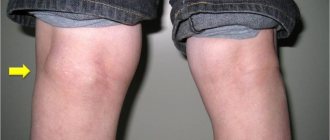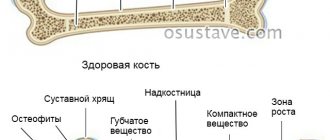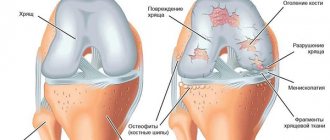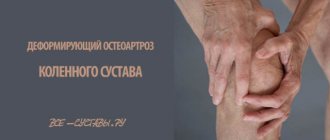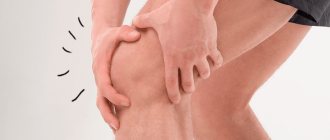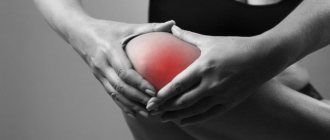Polyarthritis of the knee joint is characterized by specific symptoms, knowing which it is possible to identify the inflammatory-degenerative process at an early stage of development. Polyarthritis of the knee joint involves damage to one or both legs at the same time, initially manifested by meteosensitivity of the limbs, which affects motor activity. The pathology can be easily corrected with medications and physiotherapeutic methods, but it cannot be completely cured.
Cartilage in the 3rd degree of the disease.
Symptoms of polyarthritis of the knee joint
The pathology is characterized by a tendency to progressive damage to articular tissue and involves the synovial membrane in the inflammatory process. One of the features of polyarthritis of the knee joint is the destruction of cartilage, bone structures, and in 7 out of 10 cases - the formation of ankylosis.
Ankylosis of the right knee joint.
At the initial stage of development, the patient may not suspect that he has the disease. Signs of polyarthritis:
- Pain, swelling of the knee joints.
- Redness, local increase in body temperature, the skin of the knees is hot to the touch due to the inflammatory process.
- Morning stiffness in the joints; they change, become deformed.
- General limitation of physical activity.
The listed symptoms occur in response to injuries, infections, and autoimmune processes in the body.
Treatment of polyarthritis
Lab tests. Diagnosis of polyarthritis depends on the suspected causes of the disease. Cooperation with the best independent laboratories in the capital allows the clinic’s specialists to diagnose the causes of the disease after analyzing the patient’s biological fluids:
- blood analysis;
- Analysis of urine;
- joint fluid examination;
If the infectious nature of the disease is suspected, the following may be prescribed:
- blood tests for viruses,
- blood test for rheumatoid connective tissue lesions,
as well as examination by specialist doctors - arthrologist, orthopedist, ENT specialist, infectious disease specialist, rheumatologist.
Hardware diagnostics. X-ray and ultrasound diagnostics allow us to determine the degree of joint damage, the severity of the inflammatory process, and its cause.
Types of polyarthritis
Depending on whether polyarthritis develops independently or as a concomitant disease, its primary or secondary type is distinguished. Treatment of secondary polyarthritis is always aimed at treating the underlying disease. The typology depends on the causes and type of polyarthritis.
Rheumatoid polyarthritis is characterized by severe pain, swelling, destruction of cartilage and severe deformation of small joints. As it progresses, the mobility of the limbs is limited.
Inflammatory diseases cause loss of joint mobility, swelling and redness of the skin surrounding the affected joint in infectious polyarthritis .
Gouty (crystalline) polyarthritis is characterized by inflammation of the joints due to tissue irritation due to the deposition of uric acid salts due to impaired purine metabolism in the body.
The disease psoriasis has long-term complications in the form of the development of psoriatic polyarthritis, leading to pain and morning low joint mobility.
As a consequence of infectious diseases, including ENT, urological, herpes, ARVI, reactive polyarthritis , causing swelling of the joints and severe pain.
Post-traumatic polyarthritis after injury, fractures, joint cracks or due to osteoporosis causes crunching and discomfort in the joints when moving.
Treatment methods
Self-medication of polyarthritis using traditional methods without prior consultation with a specialist is unacceptable, as it can aggravate the symptoms of the disease, thereby complicating subsequent therapy.
Treatment of rheumatic arthritis is aimed at slowing the development of the disease, mitigating symptoms and pain, and reducing the destructive effects of the acute process. Along with medications, intra-articular injections, physical therapy and physiotherapeutic procedures are prescribed, which together help slow down the development of the disease and maintain joint mobility.
Prevention
To prevent the development of polyarthritis, you should:
- increase the overall immunity of the body;
- protect yourself from hypothermia and prolonged exposure to the open sun;
- control weight;
- adhere to a balanced diet, excluding fast food, baked goods, fatty foods, large amounts of proteins and sugar;
- monitor moderate salt intake;
- do not indulge in caffeinated drinks and soda;
- give up alcohol;
- lead an active lifestyle, not forgetting about morning exercises and walking;
- wear special orthopedic insoles, fixing bandages and bandages that protect the joint from deformation.
It should be understood that it is impossible to completely cure polyarthritis as a disease, but it is possible to soften its course and try to avoid complications by contacting an orthopedist, arthrologist, or rheumatologist as early as possible.
In order to get a consultation with an experienced orthopedist at the Miracle Doctor clinic and find out how our specialists treat polyarthritis, call or sign up through the online form.
Diagnosis of the disease
After a survey, examination and laboratory testing, the patient is referred to instrumental, auxiliary types of diagnostics.
An ultrasound of the knee joint is a quick method of studying its structures. The procedure for exposure to ultrasound for polyarthritis allows us to identify changes characteristic of the disease in question:
- uniform thickening of the synovial membrane (68% of all clinical cases);
- proliferation and formation of new blood vessels inside the tissue (50%);
- effusion into the joint capsules (56% of clinical cases) with average values (4.17 ± 2.48) mm.
An equally pronounced indicator is the result of an x-ray examination. If you perform an examination even at an early stage of the disease, you will be able to identify periarticular osteoporosis - this is one of the characteristic radiological signs that indicate polyarthritis of the knee joint.
Features of the course of the disease and types of pathology
Polyarthritis of the knee joint, as well as its treatment and symptoms, depend on the type of pathology and are distinguished by their polyethylology, i.e. various factors that provoke its occurrence.
If you determine the exact cause of the appearance, this will help to establish the variety, and clinical manifestations - the degree of expression of the pathology.
As a rule, complex therapy is selected taking into account the causes, form and course of the disease. In any case, treatment is always labor-intensive and lengthy, requiring great patience from the patient, as well as unquestioning obedience in terms of following the recommendations given by the doctor. Depending on the root cause, this disease and its treatment can be dealt with by an infectious disease specialist, an orthopedist, a traumatologist, a venereologist or some other specialist doctor.
Pathological changes in the acute form of polyarthritis of the knee joint are reversible, while in the chronic form there is only a persistent and irreversible effect.
If the patient has a mild form of the disease, this will not affect his ability to work, but a severe form can lead to restrictions or complete loss. Thus, in accordance with the form of the disease, the patient is offered different disability groups.
Treatment methods in modern medicine can help get rid of this disease completely, but it is advisable to start treatment as early as possible, otherwise, if the disease progresses to a severe form, it will be very difficult, or even impossible, to correct everything.
Types of polyarthritis of the knee joint:
- Rheumatoid.
- Rheumatic.
- Post-traumatic.
- Reactive.
- Psoriatic.
- Infectious.
- Crystal.
Treatment of polyarthritis of the knee joint
The goal of orthopedists is to draw up a therapeutic program that will solve the following issues:
- will stop the inflammatory process, relieve pain with a drug with anti-inflammatory and analgesic properties (in orthopedics, these prescriptions are formulated as “topical” therapy);
- will have an impact on the main mechanisms of pathogenetic factors (orthopedists define this part of the tactics as “basic therapy”). Helps prevent the progression of polyarthritis;
- will comprehensively implement restoration measures.
Although the disease is not completely eliminated, exposure to medications and surgery will improve a person’s motor activity and well-being.
Diagnosis of knee joint disease
Basic methods:
- Physical examination – collection of complaints, palpation, medical history.
- Ultrasound of the knee joint.
- Scintigraphy.
- Radiography.
- CT/MRI.
- Arthroscopy.
Diagnostics in laboratory conditions:
indicators - uric acid, proteins, creatinine, bilirubin, protein fractions, AST, ALT, CRP) and a general blood test (ESR and leukocyte formula).
Biochemical analysis (- Examination of joint fluid - immunological, microscopic, bacteriological, cytological.
- Analysis of urine.
Other methods:
- serological blood tests;
- Ultrasound;
- Echocardiography;
- ECG;
- PCR diagnostics;
- biopsy of the inner layer of the joint capsule.
Drug therapy
Conservative treatment involves prescribing the following medications:
- Anti-inflammatory non-steroidal drugs. They reduce the intensity and slow down the inflammatory process, affecting its source. Provides a slight analgesic effect. Diclofenac is actively used, after making sure that the patient does not have problems with the intestines or stomach (the medicine affects the mucous membrane of the gastrointestinal tract).
- Vitamin therapy . Helps normalize blood circulation in adjacent tissues. Combinations of vitamins like Neurobex are especially effective.
- Antibacterial drugs.
- Active detoxification therapy to reduce body temperature.
- Diuretics . Prescribing diuretics can reduce the load on diseased joints by reducing their swelling.
- Analgesics . Their use is advisable in combination with non-steroidal anti-inflammatory drugs for an analgesic effect.
The use of the listed drugs should be supplemented with mandatory physiotherapeutic procedures: paraffin therapy, electrophoresis, UHF.
Use of Cyclosporine
To eliminate polyarthritis, the drug Cyclosporine is actively used. It is a naturally occurring cyclic polypeptide. It is isolated from the mycelium of 2 varieties of mushrooms and is a selective immunosuppressant. The properties of the drug make it possible to selectively inhibit the proliferation and function of T-lymphocytes, especially helper cells.
The active components of the drug penetrate tissue cells through diffusion and bind to the cytoplasmic protein - cyclophyllin. It is considered as an intracellular receptor for Cyclosporine. The drug is very effective, and if used as the dominant agent in the treatment of polyarthritis, recovery can be achieved.
Cyclosporine is prescribed only at an early stage of the disease: the therapeutic effect in the form of the first improvements in well-being will occur several hours after administration of the medication.
The positive aspects of using the drug include the following qualities:
- Relatively rapid onset of therapeutic effect.
- Selective immunosuppressive property.
- The ability to influence destructive processes.
- Low incidence of cytopenia and infectious complications, which reflects the selectivity of drug-induced immunosuppression.
Cyclosporine has an inhibitory effect on so-called non-immune cells. The effect occurs on chondrocytes, osteoclasts, osteoblasts. They are able to independently produce cytokines that stimulate the processes of bone tissue absorption by inflammation.
The drug in question is not used during pregnancy, except in clinical cases of extreme necessity.
Cyclosporine is considered a better drug than the combination of non-steroidal anti-inflammatory drugs with painkillers. It provides a clear baseline effect comparable to that of gold salts and Methotrexate.
The table shows comparative characteristics regarding the side effects of each drug on the patient’s body.
| Main drug used | The drug Cyclosporine | The drug Diclofenac together with analgesics |
| Dosage and duration of the therapeutic course | The dose of the drug is from 2.5 to 5 mg/kg per day in 2 divided doses. Course – 2 weeks | 3 ml/3 times a day, course – 21 days |
| Most common side effects | When complications are detected in 80% of cases, the patient complains of the following signs:
| Nausea, lack of appetite |
| Side effects that occur infrequently | In 18% of clinical cases the following occur:
| Increased blood pressure, headache due to hypertension |
| Complications that occur rarely | In 2% of cases the following are observed:
| Dizziness, increased heart rate |
Despite the high likelihood of side effects, Cyclosporine is considered quite effective.
The occurrence of rheumatoid polyarthritis of the knee joint
The symptoms of rheumatoid polyarthritis are floating, i.e. varies depending on the form, but treatment should not be delayed. In the classical form, mirror lesions of the knees with small joints of the arms are quite often noticed.
The disease develops smoothly, gradually. There is no swelling, or it is barely noticeable. At first, morning stiffness is almost unnoticeable, weakly expressed, which does not bother the person at first. As it progresses, this becomes more pronounced, plus unpleasant symptoms such as muscle atrophy and coldness of the extremities appear.
But the pseudoseptic form is already accompanied by high fever, chills, severe sweating, vasculitis, and articular manifestations are weakly expressed or completely absent.
The articular-visceral form is characterized by a combination where the joints are affected along with serious disorders of the internal organs.
Signs of reactive polyarthritis
It begins its development several weeks after suffering an acute infectious disease.
The onset is immediately “acute”, accompanied by joint pain, chills, general malaise and febrile temperature.
Also, we will not exclude simultaneous inflammation of the mucous membranes, for example, stomatitis, urethritis or conjunctivitis. The acute process can last from 7 days to 3 months, and then becomes chronic.
Symptoms of crystalline polyarthritis
The picture of this type of polyarthritis is caused by the deposition of urea in the form of crystals inside the joints.
This type of polyarthritis has a relapsing course. The disease can strike suddenly with acute pain in a large joint or articular joint, accompanied by swelling, local hyperthermia and redness of the skin.
The attack can last up to four days, and then the symptoms disappear safely, misleading the person, since it will recur from time to time. In the future, the duration of attacks increases and decreases at intervals.
How does infectious specific polyarthritis of the knee joint manifest?
One, but more often two knee joints begin to become inflamed against the background of ongoing syphilis, gonorrhea, dysentery, brucellosis and other infections. With syphilis, large joints are affected in the tertiary period. Palpation is painful, the pain intensifies at night.
Polyarthritis due to gonorrhea begins suddenly within the next month after infection. Distinctive signs are high fever, sharp pain in the hips, knees, and elbows.
But the symptoms of polyarthritis due to brucellosis are wavy fever, swelling, pain, redness of the skin, limited movement, enlarged liver, lymph nodes, spleen.
Surgical intervention
Currently, of all the options for surgical treatment of the knee joint, total endoprosthetics is recognized as the most effective. The intervention helps achieve the following goals:
- carry out medical and social rehabilitation;
- relieve debilitating pain syndrome;
- improve the motor activity of the inflamed joint;
- normalize the patient’s quality of life.
In most clinical cases, the decision to install an endoprosthesis with subsequent replacement of the posterior cruciate ligament is justified.
Clear signs of bone osteoporosis and the presence of pathological changes in the ligamentous part of the knee joint are indications for searching for a method of preserving the functionality of the limb. The use of endoprostheses with fixation of its components with cement is considered appropriate. This solution ensures that the primary components are firmly and stably fixed. Orthopedists, together with surgeons, practice supplementing bone cement with gentamicin, which in 9 out of 10 cases serves as a factor that positively affects the rate of healing and postoperative recovery of the leg .
Since the patient’s body is characterized by immunosuppression, doctors focus on the following aspects:
- creating favorable conditions for low-traumatic surgery;
- gentle treatment of tissues during surgery;
- prevention of thrombosis;
- preventive measures regarding the possible occurrence of complications of infectious origin.
When knee replacement is performed in patients with polyarthritis, total synovectomy is performed in 80% of cases.
This type of surgical intervention is accompanied by massive blood loss during surgery and during the early postoperative recovery of the patient. This is one of the reasons for the presence of extensive hematomas of the skin over the operated knee joint. Often the bruises reach the lower leg. In 50% of cases, the symptom is observed in patients who underwent surgical treatment of polyarthritis, characterized by pronounced degenerative changes.
The main signs of knee polyarthritis
The symptoms of polyarthritis of the knee joint have their own characteristics for different types of treatment, which are characteristic of different diseases, but among them they have common symptoms:
In the acute form of the disease, a pain syndrome is characteristic in the extreme stage, when the pain is sharp and appears in several joints at once, or appears sequentially, when both knees first begin to cause trouble, alternately, with an interval of several days. This figurative “volatility” of pain is inherent only in the affected joints.
Pain.
Limited movement in the morning gives way to the restoration of movement during the day.
Stiffness.- Swelling of the knee. In almost all cases, the joint that is inflamed becomes swollen.
- Skin hyperemia. Redness appears in the area of inflammation.
Increase in skin temperature when placing a hand on a sore joint.
Hyperthermia of the skin in the inflamed area.- Meteosensitivity. Shortly before a change in weather conditions, be it rain or heat, pain in the joints intensifies, and if they were not there before, they resume.
- Fatigue, sweating, loss of appetite, general malaise.
- Development of deformation. Appears at stages 2 and 3.
In the chronic form, the strength of the aching wave-like pain can intensify with loads on the joint in the morning and at night.
ethnoscience
Folk methods cannot get rid of polyarthritis . This is a fairly serious disease, and therefore it cannot be stopped experimentally. By relying on the methods of unofficial medicine, you can waste time, allowing the disease to progress to a more severe stage.
However, using traditional methods can reduce pain. And salted wool helps with this - a non-standard, at first glance, method.
- Prepare a decoction of anti-inflammatory herbs: thyme, chamomile, yarrow, St. John's wort and calendula (marigold) - all these medicinal plants are suitable as raw materials.
- For 1 liter of herbal decoction add 4 tbsp. spoons of salt (not table salt, but sea salt).
- Thoroughly soak woolen fabric or whole, untreated wool (sheepskin or other) in the prepared medicinal solution.
- Then dry, avoiding any wet areas inside the fibers.
- After making sure the coat is completely dry, wrap the inflamed joints before going to bed.
The manufactured device should warm up the problem area of the body throughout the night.
How do you know if your knee is affected by polyarthritis?
Polyarthritis is a disease that affects several joints. The joints can get sick at the same time, or they can start hurting one after another.
Polyarthritis of the knee joint is a pathology that has reached both knees. The disease occurs frequently; in 75% of cases, polyarthritis primarily affects the knee joints, and then can spread to other joints. In this case, the intra-articular tissue and the tissue around the joint become inflamed, the disease is chronic.
Signs of polyarthritis are:
- swelling, redness of the joints;
- local hyperemia;
- stiffness of movements;
- periodic pain.
Symptoms are characteristic of non-infectious polyarthritis.
Then, as the pathology develops, a person may notice enlargement of the joints, and the pain may intensify with physical activity. The main difference between the pain of polyarthritis and the pain of most joint diseases is that it intensifies at rest. Rheumatology patients often experience acute, distressing symptoms during sleep.
Depending on the causes of the disease, the pain may be of a different nature, and the following symptoms may also be identified:
- weakness;
- increase in general temperature;
- lack of appetite.
Such signs are characteristic of infectious polyarthritis.
Read about treatment for tendinosis here.
Further, if a person does not take any measures to get rid of the disease, polyarthritis will affect the functioning of the internal systems of the body:
- heart;
- Gastrointestinal tract;
- kidneys;
- lungs.
Polyarthritis often causes complications on visual function - a person may feel “sand in the eyes,” and vision will gradually decrease.
For reference! Polyarthritis develops extremely slowly, symptoms may subside and then recur with renewed vigor.


